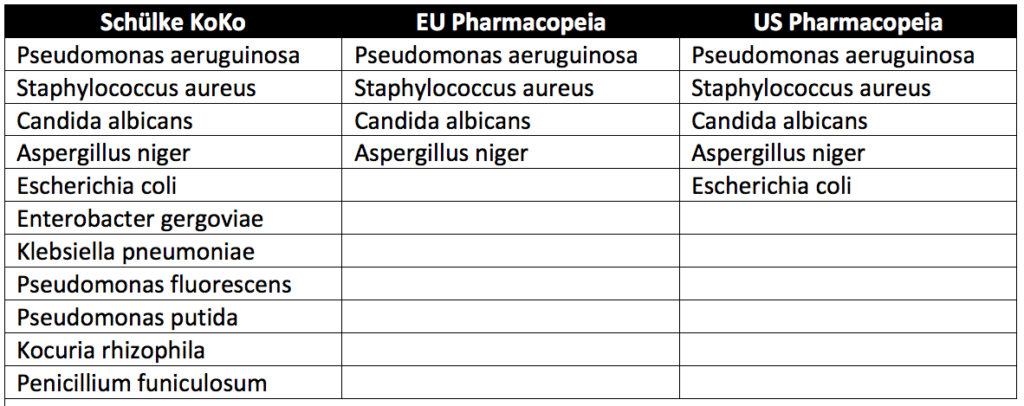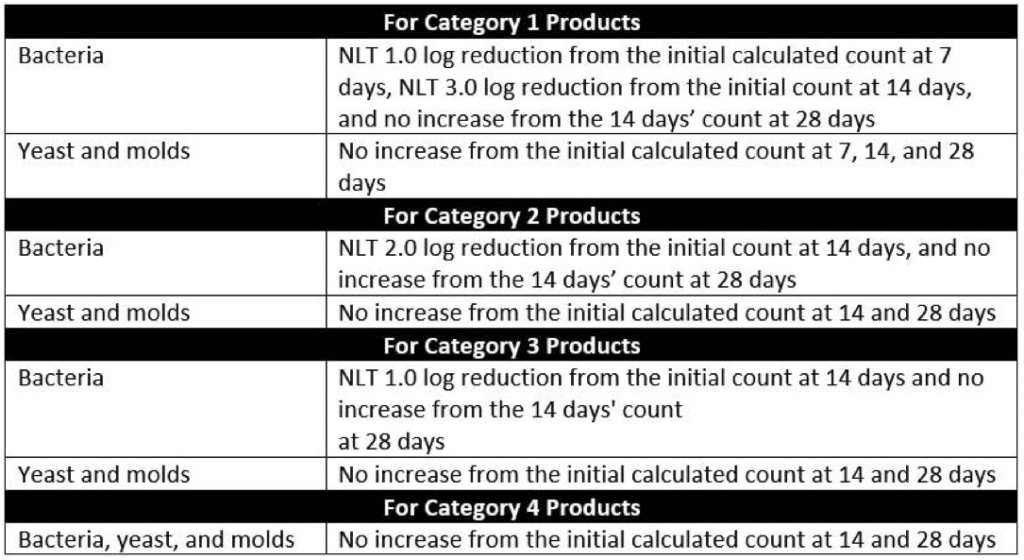Preservative Challenge Testing For Cosmetic Products
The current market size for beauty and cosmetic products is 49.2 billion dollars. Many of these products are topical cosmetic products such as gels, creams, ointments, and lotions. Topical formulations are made up of a water or oil base optimized to deliver various medications, natural substances (such as herbs), or moisture through the skin. Topical cosmetics contain preservatives to support the stability of the formulation and prevent microbial growth during repeated product use.
Preservative efficacy testing (PET), also known as preservative challenge testing, determines the effectiveness of a preservative during its shelf life and evaluates how well a product withstands microbial contamination during use. For example, in sterile vials containing multiple doses, antimicrobial preservatives are used to inhibit the growth of any microorganisms that may be introduced during repeated insertion and withdrawal to load individual amounts.
PET can also be used to determine the best preservative to use in your topical formulation and the minimum effective concentration of that particular preservative needed to preserve the pharmaceutical, food, or biotechnology product being assessed. Note that the minimum effective concentration of a preservative should be well below any concentration level that is toxic to humans.
Three approaches are used in preservative challenge testing. These approaches come from the Schülke KoKo Test, United States Pharmacopeia (USP), and the European Pharmacopeia. The focus of this article is to compare the Schülke KoKo Test, USP, and European Pharmacopeia recommendations so that you can determine which microorganisms to include in your preservative efficacy testing.
Schülke KoKo Test vs. U.S. Pharmacopeia vs. European Pharmacopeia
In the European Union, Pseudomonas aeruginosa, Staphylococcus aureus, Aspergillus niger, and Candida albicans must be tested for all cosmetic products. In addition to the microbes above, testing with microbes known to lead to spoilage of cosmetic products is recommended but not required. In the United States, the USP guidelines require testing of Escherichia coli in addition to Pseudomonas aeruginosa, Staphylococcus aureus, Aspergillus niger, and Candida albicans. Spoilage microbes are not needed for PET. In contrast to the pharmacopeia tests, which only evaluate pathogenic microbes, the Schülke KoKo test evaluates product spoiling microorganisms. Schülke KoKo test’s spoiling microorganisms are based on decades of cosmetic testing experience from Schülke & Mayr in Germany.
USP preservative efficacy testing evaluates cosmetic products by exposing them to a single microbial strain at a time. Additional details on USP preservative challenge testing, which follows similar procedures to the European Pharmacopeia, can be found through reading our articles on Preservative Challenge Testing And USP 51 and Preservative Efficacy Testing For Medical Devices. In contrast, for the Schülke KoKo test, the single cultivated microbes are brought together into a mixed suspension for inoculation of the cosmetic product. A new mixed suspension is prepared for each of the six inoculation cycles for Schülke KoKo testing. Since the Schülke KoKo test uses a mixed microbe inoculation, it simulates microbial exposure of a product during production, filling, and use. Indeed, a product would likely be exposed to multiple microbes at once instead of one at a time. Overall, though different from the USP and European Pharmacopeia methods, the Schülke KoKo Test is a reliable test method for assessing the efficacy of antimicrobial preservation of cosmetic products.

Acceptance Criteria for Schülke KoKo Test
In the Schülke KoKo test, a sample is well preserved if it passes six weeks under culture with the mixed inoculum without showing microbial growth on the test batches. Even after the sixth inoculation, no microbial growth can be observed to pass the Schülke KoKo test.
Acceptance Criteria for European Pharmacopeia
The European Pharmacopeia has two sets of acceptance criteria following microbial and fungal inoculation, criteria A and criteria B. For criteria A, bacteria must have a log 2 reduction at 2 days, a log 3 reduction at 7 days and 14 days, and no increase in microbial growth at 28 days following inoculation. Additionally, criteria A for fungi includes no increase in growth at day 2 and day 7, a log 2 reduction at day 14, and no increase in fungal growth at day 28. For criteria B, bacteria must have no gain in microbes at day 2 and day 7, a log 3 reduction in growth at day 14, and no increase in microbial growth at day 28. Criteria B for fungi includes no increase in gain in microbes on day 2 and day 7, a log 1 reduction in growth by day 14, and no increase in growth on day 28 of inoculation. Criteria A is the primary acceptance criteria. Criteria B may be used only in justified cases where criteria A cannot be met, such as for reasons of an increased risk of adverse reactions.
Acceptance Criteria for U.S. Pharmacopeia
For preservative efficacy testing, each of the five product samples with their respective microbial injections is incubated at a simulated room temperature of 22.5 ± 2.5°C or 32.5 ± 2.5°C depending upon the microbe the product sample is exposed. Microbial counts are taken at 7, 14, and 28 days for most microorganisms tested. The plate-count method is used to determine the number of CFU present in each of the inoculated product samples. This plate-count method is completed in duplicate. Once all counts are taken, the change in log10 of the concentration of CFU/ml is calculated for each microorganism. The requirements for antimicrobial effectiveness are met if no increase in microbial growth for the various organisms tested occurs within the timeframes specific to each organism are met. No increase in microbial growth is defined as not more than 0.5 log10 units more than the previous microbial growth value. Table 3 of USP 51, reproduced as Table 3 below, details the criteria for tested microorganisms. Note that no increase in microbial growth is defined as not more than 0.5 log10 units more than the previous microbial growth value.

Summary
Topical cosmetics contain preservatives to support their formulation’s stability and prevent microbial growth during repeated product use. Preservative efficacy testing (PET), also known as preservative challenge testing, determines the effectiveness of a preservative during its shelf life and evaluates how well a product withstands microbial contamination during use. There are three recommendations for the types of microorganisms used in preservative challenge testing. These recommendations come from the Schülke KoKo Test, United States Pharmacopeia (USP), and the European Pharmacopeia. Schülke KoKo testing involves inoculating with multiple microbes at once. On the other hand, USP and European pharmacopeia testing methods evaluate cosmetics one microbe at a time. PET testing following USP recommendations includes all of the microorganisms recommended for the European Pharmacopeia. The Schülke KoKo test is specifically designed to assess cosmetic products and includes pathogenic and spoiling microorganisms for preservative challenge testing. Suppose you have a topical product that you would like to remain free of contamination and early spoilage during usage. In that case, it is recommended to perform traditional USP preservative efficacy testing and Schülke KoKo testing.
MycoScience is a contract manufacturing organization specializing in sterile syringe and vial filling. MycoScience also offers Preservative Efficacy Testing, Sterilization Validations, Bioburden Testing, Cleaning Validations, Microbial Aerosol Challenge Testing, Accelerated Aging, Microbiology Testing, Cytotoxicity Testing, Bacterial Endotoxin Testing, EO Residual Testing, Package Integrity Testing & Environmental Monitoring services medical devices and allied industries. MycoScience is an ISO 13485 certified facility.
References
Ridder. Revenue of the cosmetic and beauty industry in the United States from 2002 to 2020. Statista. November 2020.
Wolfgang Siegert. Evaluation Of The Microbial Safety Of Finished Cosmetic Products. European Cosmetics. March 2010. 16-19pg.
United States Pharmacopeial Convention. <51> Antimicrobial Effectiveness Testing. Rockville, MD, USA. 2021. (USPC <51>).
Sharing this in your social netwroks

